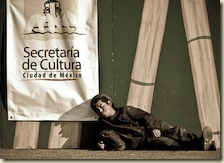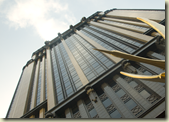Less is more
In terms of equipment less is more. If you are traipsing the streets of a city for hours on end you'll want to cut down on the baggage so a good pair of walking shoes and a comfortable camera strap should not be negotiated. Additionally youll want to blend in to catch subjects unawares; erecting a tripod or using a telephoto lens wont suggest sublety
Off the beaten track
Street photography is not tourist photography, so go off the beaten track and capture what us being done behind the scenes. Goung out an an unusual timecan help you find great shots and because street photography us nit dependent of perfect light settings, you have no excuse not to get out early and say out until late
Stolen Moments
The key to successful street shooting us to be on the lookout for an opportunity before it happens. Anticipate action by scouring groups of potential clashes or bonds, judge the atmosphere of a crowd and react to the body language and facial expressions
True Colours
Colorful clothing or backgrounds can sometimes be a distraction when you want to concentrate on facial expressions and gesture, and for this reason the genre blends itself to black and white. However, there will be opportunities where lurid and gaudy colours collide and it would be a crime to convert to B&W
In the background
By paying attention to the background, you can catch some stolen movements, Look for billboards. signs, graffiti or other visual elements that could be used to make humorous, ironic or incongruous statements
Dare to go diagonal
Exploit the diagonal lines and perspectives of the urban architecture. By playing with angles and available geometries you provide force and dynamism and a kind of harmony between the man and the urban architecture
Opposites attract
Look for compositions that reveal dichotomy to build a story or challenge and assumption. Try splitting the composition between the reflections on the ground and the scene above or capture part of a building half i nthe dark, half in the light
Performance
Street entertainers make ideal subjects, but try to capture from a different viewpoint, Wether its a parade, buskers, free runners, skateboarders, or breakdancers they offer something a little different to your average street scene. Experiment with your compositions and choose a high shutter speed to capture the action
Off the Streets
Despite its name the genre does lend itself to other recreational areas especially those where people expect cameras to be present. Seaside, fairgrounds, parks, zoo, sporting events or the zoo
New angle
Get down low or find a higher viewpoint for an unusual angle. Multi story car parks are great for this, as you dont have to shoot through glass and give a viewpoint in town centers. Be careful that your camera is secured; the last thing you want is to drop your camera and hurt someone.
Practice makes perfect
With your camera pre-set pick a spot on the street and proceed with calmness sesitivity and poise. With practice you will make great street photographs
Fortune favors the brave
If your pictures arent good enough, you are not close enough. Shots taken in the thich of the action will draw the viewer in. so force yourself to press the button and prepare to deal with the consequences, Better that than regretting missing an opportunity that will never happen again
Fun in the Sun
Use the sun's glare ti your advantage. When the sun is low in urban environments it produces long shadows and shafts if light, creating high contrast patch works, This can trouble a camera's meter. so make sure you use the manual mode and expose for the highlights
Ready to pounce
The opportunity for a great shot may be fleeting so be cued up and ready to shoot. Have your camera out, finger at the ready and for when the situation demands, matrix metering and autofocus activated
Revise and Revisit
If you see a scene that has potential dont be afraid of revisiting the same location and spend some time there to get a better shot. Revisit in different weather conditions and different times of the year to see a change
Frozen motion
Movement is a key part of capturing the human zoo. Keep shutter speeds fast and at hand steady or find something to support your camera. To capture people moving across af rame a minimum of 1/125 sec is recommend and an ISO not slower than 400
Street wallpaper
I prefer it if my subjects don’t know Im there, or else are too busy to be aware of my presence.
Life trough a lense
Exaggerating perspective will help set your subject in context and provide am more forgiving DOF thats why most street photographers say a lightweight wide angle lense is their weapon of choice Also consider fisheye lenses and the potential of panoramic shoots
Expect the Expected
People are generally more suspicious in today's social climate, which makes street photography a potential minefield of hot-tempered confrontation. Try shooting subjects in places where people expect shots to be taken, but be aware that you may be regarded with suspicion, Smile, be polite and be willing to delete images if the subject asks
Location, Location, Location
Places where people interact with one another are a prime target for street photography, street corners, pedestrian crossings, outside piublic houses, bus stops, woekers puring into the streets at rush hour, etc. As crowding increases people's personal space decreases allowing you and your camera to get much closer.
Sign reds... Ministry of Culture...



















